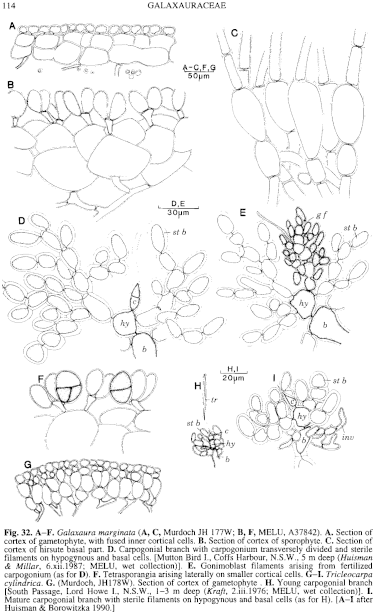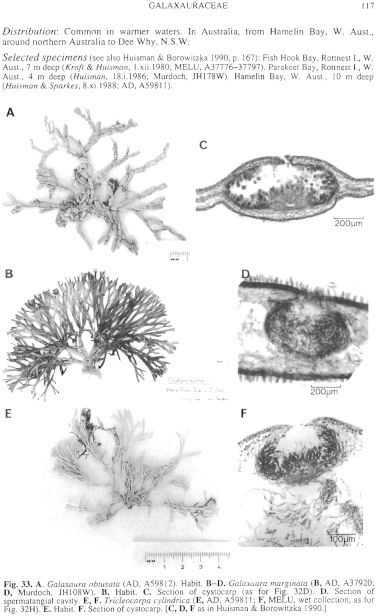|
|
|
|
|
|||||||||||
|
Electronic Flora of South Australia Species Fact Sheet
Phylum Rhodophyta – Class Florideophyceae – Order Nemaliales – Family Galaxauraceae
Selected citations: Harvey 1860b: pl. 136. Howe 1918: 193, figs 1, 2, pls 3, 4 fig. 1. Huisman & Borowitzka 1990: 157, figs 14–27. Kjellman 1900: 77, pl. 20 fig. 44. Millar 1990: 304, fig. 6A–G. Papenfuss et al. 1982: 411, figs 7–9, 24, 36, 37.
Synonyms
Corallina marginata Ellis & Solander 1786: 115, pl. 22 fig. 6.
G. arborea Kjellman 1900: 72, pl. 11 figs 1–11, p1. 20 fig. 39.
G. laxa Kjellman 1900: 71, pl. 10 figs 15–22, pl. 20 fig. 22. Levring 1953: 514. G. spathulata Kjellman 1900: 74, pl. 12 figs 5–12, pl. 20 fig. 35.
Brachycladia marginata (Ellis & Solander) Schmitz 1889: 438. Womersley 1948: 161.
Thallus (Fig. 33B) dark red-brown, often grey-red above, 4–15 (–20) cm high, much branched subdichotomously usually every 0.5–2 cm, branches flat, superficially smooth surfaced, (1–) 1.5–2.5 (–3) mm broad, 300–500 µm thick, not jointed but often with transverse banding and a thicker margin forming a ridge on drying; such branch systems arising from branched, terete, tomentose stipes 0.2–3 cm long and 1–3 mm in diameter, often with a tuft of longer filaments at the stipe apices (Fig. 32C) and below the flat branches. Holdfast discoid, 0.5–2 cm across; epilithic. Structure (Fig. 32A, B) of a pseudoparenchymatous cortex 2–3 cells thick, cells more or less isodiametric to ovoid, 30–45 µm across, with a central medulla of coarse filaments 10–15 µm in diameter with cells mostly L/D 4–8. Cortex in tetrasporophytes (Fig. 32B) bearing a surface layer of 2 or 3-celled filaments, separated and with calcification between them on the pseudoparenchymatous surface, the outermost cells more or less pyriform, outwardly truncated, 20–30 µm in diameter and 30–40 µm long; in gametophytes (Fig. 32A), outer cortical layer compact, of isodiametric cells, polygonal in surface view and outwardly truncated, (12–) 15–20 µm across, usually (especially in female plants) each bearing a clavate cell 20–25 µm long and 10–14 µm in diameter, with rounded to slightly apiculate ends; calcification in gametophytes in the outer medulla. Rhodoplasts campanulate with a central pyrenoid.
Reproduction: Sexual thalli dioecious. Carpogonial branches 3-celled (Fig. 32D), borne in the young cortex, with the hypogynous cell cutting off four large-celled branches and the basal cell four branches of smaller cells. Gonimoblast filaments (Fig. 32E) from the fertilized carpogonium curve towards the surface to form the cystocarp wall. Cystocarps (Fig. 33C) 300–600 µm in diameter, ostiolate, producing sessile or shortly pedicellate carposporangia, clavate when young, ovoid when mature, (25–) 40–60 µm long and (12–) 20–40 µm in diameter. Male conceptacles (Fig. 33D) 200–400 µm in diameter, with tufts of branched filaments projecting inwards from the wall, with terminal and lateral ovoid spermatangia 4–6 µm in diameter and 6–8 µm long.
The tetrasporophyte with cruciately divided tetrasporangia (Fig. 32F), subspherical, 30–40 µm in diameter, borne laterally below the terminal cell of the short filaments on the cortex.
Type from the Bahama islands; lost, lectotypified by Ellis & Solander 1786, pl. 22 fig. 6 (see Papenfuss et al. 1982, p. 411).
Selected specimens: Parakeet Bay, Rottnest I., W. Aust., 6 m deep (Mercer, 7.xii.1984; AD, A56643, female). Gnarabup Beach, W. Aust., reef pools (Womersley, 1.ix.1979; AD, A50686, sexual and sporangial). Hamelin Bay, W. Aust., 10 m deep (Huisman, 8.xi.1986; Murdoch, JH180W). Augusta, W. Aust., (Huisman, 3.v.1986; Murdoch, JH177W). Scott Bay, S. Aust., in shaded pools (Womersley, 27.i.1951; AD, A13849, sporangial). Masillon I., Isles of St Francis, S. Aust., 1–4 m deep (Shepherd, 5.i.1971; AD, A37920, sporangial). Waterloo Bay, S. Aust., 3–5 m deep (Shepherd, 1.xi.1981; AD, A52745, sporangial); 11 m deep (Shepherd, 19.iv.1970; AD, A35866, male); 13 m deep (Shepherd, 26.ii.1978; AD, A55024, cystocarpic), and 6–9 m deep (Branden, 14.ii.1985; AD, A56669, with extensive basal terete parts). Pondalowie Bay, S. Aust., 5–8 m deep (Shepherd, 14.iv.1963; AD, A26587). Pennington Bay, Kangaroo I., S. Aust., drift (Womersley, 27.i.1946; AD, A2882). Point Lonsdale, Vic. (Kraft, 20.i.1975; MELU, A37842). Bastion Point, Mallacoota, Vic., drift (Womersley, 11.viii.1959; AD, A23126, cystocarpic). Bluestone Bay, Freycinet Pen., Tas., 10–13 m deep (Brown, McGeary & Womersley, 4.xi.1982; AD, A56251, male and tetrasporangial). Kurnel, N.S.W., drift (Womersley, 26.xii.1962; AD, A26379, sporangial). Batteau Bay, Terrigal, N.S.W., 4–6 m deep (Taaffe, 14.i.1974; AD, A44846, sporangial).
Distribution: Widespread in tropical and subtropical seas.
Extending from western and eastern Australian coasts around southern Australia and Tasmania.
Taxonomic notes: The southern Australian specimens of this subtropical to temperate species are moderately common in many areas and known from as far south as the Freycinet Peninsula in Tasmania. Occasional specimens (eg. AD, A56669) have extensive terete basal parts 3–8 cm long, much branched, with only very short, flat, upper branches; such basal parts superficially resemble G. lapidescens (Ellis & Solander) Lamouroux.
Papenfuss et al. (1982, p. 411) placed 5 of Kjellman's species in synonymy under G. marginata, and three further Kjellman species were included by Huisman & Borowitzka (1990, p. 157). Southern Australian synonyms only are listed in the species synonymy above.
References:
ELLIS, J. & SOLANDER, D. (1786). The Natural History of many curious and uncommon zoophytes, collected from various parts of the globe, by the late John Ellis, Esq. F.R.S. (B.White & Son: London.)
HARVEY, W.H. (1860b). Phycologia Australica. Vol. 3, Plates 121–180. (Reeve: London.)
HOWE, M.A. (1918). Further notes on the structural dimorphism of sexual and tetrasporic plants of the genus Galaxaura. Brooklyn Bot. Gard. Mem. 1, 191–197, Plates 3, 4.
HUISMAN, J.M. & BOROWITZKA, M.A. (1990). A revision of the Australian species of Galaxaura (Rhodophyta, Galaxauraceae), with a description of Tricleocarpa gen. nov. Phycologia 29, 150–172.
KJELLMAN, F.R. (1900). Om Floridé-slägtet Galaxaura dess organografi och systematik. K. Svenska Vetensk. Akad. Handl. 33(1), 1–109, Plates 1–20.
LAMOUROUX, J.V.F. (1816). Histoire des Polypiers Coralligènes Flexibles. (Poisson: Caen.)
LEVRING, T. (1953). The marine algae of Australia. I. Rhodophyta: Goniotrichales, Bangiales and Némalionales. Arkiv för Bot. Ser. 2, 2, 457–530.
MILLAR, A.J.K. (1990). Marine Red Algae of the Coffs Harbour Region, northern New South Wales. Aust. Syst. Bot. 3, 293–593.
PAPENFUSS, G.F., MSHIGENI, K.E. & CHIANG, Y.-M. (1982). Revision of the red algal genus Galaxaura with special reference to the species occurring in the western Indian Ocean. Bot. Mar. 25, 401–444.
SCHMITZ, F. (1889). Systematische Uebersicht der bisher bekannten Gattungen der Florideen. Flora, Jena 72, 435–456, Plate 21.
WOMERSLEY, H.B.S. (1948). The marine algae of Kangaroo Island. H. The Pennington Bay Region. Trans. R. Soc. S. Aust. 72, 143–166, Plates 10–15.
The Marine Benthic Flora of Southern Australia Part IIIA complete list of references.
Publication:
Womersley, H.B.S. (14 January, 1994)
The Marine Benthic Flora of Southern Australia
Rhodophyta. Part IIIA, Bangiophyceae and Florideophyceae (to Gigartinales)
Reproduced with permission from The Marine Benthic Flora of Southern Australia Part IIIA 1994, by H.B.S. Womersley. Australian Biological Resources Study, Canberra. Copyright Commonwealth of Australia.
Illustrations in Womersley Part IIIA, 1994: FIGS 32 A–F, 33 B–D.

Figure 32 enlarge
Fig. 32. A–F. Galaxaura marginata (A, C, Murdoch JH 177W; B, F, MELU, A37842). A. Section of cortex of gametophyte, with fused inner cortical cells. B. Section of cortex of sporophyte. C. Section of cortex of hirsute basal part. D. Carpogonial branch with carpogonium transversely divided and sterile filaments on hypogynous and basal cells. [Mutton Bird I., Coffs Harbour, N.S.W., 5 m deep (Huisman & Millar, 6.xii.1987; MELU, wet collection)]. E. Gonimoblast filaments arising from fertilized carpogonium (as for D). F. Tetrasporangia arising laterally on smaller cortical cells. G–I. Tricleocarpa cylindrica. G. (Murdoch, JH178W). Section of cortex of gametophyte . H. Young carpogonial branch [South Passage, Lord Howe I., N.S.W., 1-3 m deep (Kraft, 2.iii.1976; MELU, wet collection)]. I. Mature carpogonial branch with sterile filaments on hypogynous and basal cells (as for H). [A–I after Huisman & Borowitzka 1990.]

Figure 33 enlarge
Fig. 33. A. Galaxaura obtusata (AD, A59812). Habit. B–D. Galaxaura marginata (B, AD, A37920; D, Murdoch, JH108W). B. Habit. C. Section of cystocarp (as for Fig. 32D). D. Section of spermatangial cavity. E, F. Tricleocarpa cylindrica (E, AD, A59811; F, MELU, wet collection, as for Fig. 32H). E. Habit. F. Section of cystocarp. [C, D, F as in Huisman & Borowitzka 1990.]

|
Email Contact: State Herbarium of South Australia |

|